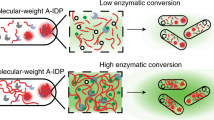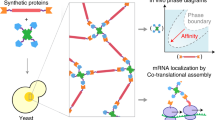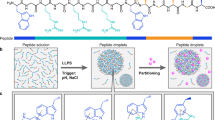Abstract
Dynamic protein-rich intracellular structures that contain phase-separated intrinsically disordered proteins (IDPs) composed of sequences of low complexity (SLC) have been shown to serve a variety of important cellular functions, which include signalling, compartmentalization and stabilization. However, our understanding of these structures and our ability to synthesize models of them have been limited. We present design rules for IDPs possessing SLCs that phase separate into diverse assemblies within droplet microenvironments. Using theoretical analyses, we interpret the phase behaviour of archetypal IDP sequences and demonstrate the rational design of a vast library of multicomponent protein-rich structures that ranges from uniform nano-, meso- and microscale puncta (distinct protein droplets) to multilayered orthogonally phase-separated granular structures. The ability to predict and program IDP-rich assemblies in this fashion offers new insights into (1) genetic-to-molecular-to-macroscale relationships that encode hierarchical IDP assemblies, (2) design rules of such assemblies in cell biology and (3) molecular-level engineering of self-assembled recombinant IDP-rich materials.
This is a preview of subscription content, access via your institution
Access options
Access Nature and 54 other Nature Portfolio journals
Get Nature+, our best-value online-access subscription
$29.99 / 30 days
cancel any time
Subscribe to this journal
Receive 12 print issues and online access
$259.00 per year
only $21.58 per issue
Buy this article
- Purchase on Springer Link
- Instant access to full article PDF
Prices may be subject to local taxes which are calculated during checkout




Similar content being viewed by others
References
Rubinstein, M. & Colby, R. Polymers Physics (Oxford Univ. Press, 2003).
Long, M. S., Jones, C. D., Helfrich, M. R., Mangeney-Slavin, L. K. & Keating, C. D. Dynamic microcompartmentation in synthetic cells. Proc. Natl Acad. Sci. USA 102, 5920–5925 (2005).
Li, P. et al. Phase transitions in the assembly of multivalent signalling proteins. Nature 483, 336–340 (2012).
Luby-Phelps, K. The physical chemistry of cytoplasm and its influence on cell function: an update. Mol. Biol. Cell 24, 2593–2596 (2013).
Hyman, A. A. & Simons, K. Beyond oil and water—phase transitions in cells. Science 337, 1047–1049 (2012).
Nott, T. J. et al. Phase transition of a disordered nuage protein generates environmentally responsive membraneless organelles. Mol. Cell 57, 936–947 (2015).
Han, T. W. et al. Cell-free formation of RNA granules: bound RNAs identify features and components of cellular assemblies. Cell 149, 768–779 (2012).
Kato, M. et al. Cell-free formation of RNA granules: low complexity sequence domains form dynamic fibers within hydrogels. Cell 149, 753–767 (2012).
Weber, S. C. & Brangwynne, C. P. Getting RNA and protein in phase. Cell 149, 1188–1191 (2012).
Parker, R. & Sheth, U. P bodies and the control of mRNA translation and degradation. Mol. Cell 25, 635–646 (2007).
Bernardi, R. & Pandolfi, P. P. Structure, dynamics and functions of promyelocytic leukaemia nuclear bodies. Nat. Rev. Mol. Cell Biol. 8, 1006–1016 (2007).
An, S., Kumar, R., Sheets, E. D. & Benkovic, S. J. Reversible compartmentalization of de novo purine biosynthetic complexes in living cells. Science 320, 103–106 (2008).
Elbaum-Garfinkle, S. et al. The disordered P granule protein LAF-1 drives phase separation into droplets with tunable viscosity and dynamics. Proc. Natl Acad. Sci. USA 112, 7189–7194 (2015).
Nott, T. J., Craggs, T. D. & Baldwin, A. J. Membraneless organelles can melt nucleic acid duplexes and act as biomolecular filters. Nat. Chem. 8, 569–575 (2016).
Roberts, S., Dzuricky, M. & Chilkoti, A. Elastin-like polypeptides as models of intrinsically disordered proteins. FEBS Lett. 589, 2477–2486 (2015).
Meyer, D. E. & Chilkoti, A. Purification of recombinant proteins by fusion with thermally responsive polypeptides. Nat. Biotech. 17, 1112–1115 (1999).
Urry, D. W. Physical chemistry of biological free energy transduction as demonstrated by elastic protein-based polymers. J. Phys. Chem. B 101, 11007–11028 (1997).
McDaniel, J. R., Radford, D. C. & Chilkoti, A. A unified model for de novo design of elastin-like polypeptides with tunable inverse transition temperatures. Biomacromolecules 14, 2866–2872 (2013).
Pak, C. W. et al. Sequence determinants of intracellular phase separation by complex coacervation of a disordered protein. Mol. Cell 63, 72–85 (2016).
Meyer, D. E. & Chilkoti, A. Genetically encoded synthesis of protein-based polymers with precisely specified molecular weight and sequence by recursive directional ligation: examples from the elastin-like polypeptide system. Biomacromolecules 3, 357–367 (2002).
Meyer, D. E. & Chilkoti, A. Quantification of the effects of chain length and concentration on the thermal behavior of elastin-like polypeptides. Biomacromolecules 5, 846–851 (2004).
Dreher, M. R. et al. Temperature triggered self-assembly of polypeptides into multivalent spherical micelles. J. Am. Chem. Soc. 130, 687–694 (2008).
Cho, Y. et al. Effects of Hofmeister anions on the phase transition temperature of elastin-like polypeptides. J. Phys. Chem. B 112, 13765–13771 (2008).
Hassouneh, W., Zhulina, E. B., Chilkoti, A. & Rubinstein, M. Elastin-like polypeptide diblock copolymers self-assemble into weak micelles. Macromolecules 48, 4183–4195 (2015).
Mart, R. J., Osborne, R. D., Stevens, M. M. & Ulijn, R. V. Peptide-based stimuli-responsive biomaterials. Soft Matter 2, 822–835 (2006).
Cahn, J. W. & Hilliard, J. E. Free energy of a nonuniform system. I. Interfacial free energy. J. Chem. Phys. 28, 258–267 (1958).
Nesterov, A. E. & Lipatov, Y. S. Thermodynamics of Polymer Blends Vol. 1 (CRC, 1998).
Brangwynne, C. P., Mitchison, T. J. & Hyman, A. A. Active liquid-like behavior of nucleoli determines their size and shape in Xenopus laevis oocytes. Proc. Natl Acad. Sci. USA 108, 4334–4339 (2011).
Petsev, D. N., Wu, X., Galkin, O. & Vekilov, P. G. Thermodynamic functions of concentrated protein solutions from phase equilibria. J. Phys. Chem. B 107, 3921–3926 (2003).
Schmidt, H. B. & Rohatgi, R. In vivo formation of vacuolated multi-phase compartments lacking membranes. Cell Rep. 16, 1228–1236 (2016).
Feric, M. et al. Coexisting liquid phases underlie nucleolar subcompartments. Cell 165, 1686–1697 (2016).
Jain, S. et al. ATPase-modulated stress granules contain a diverse proteome and substructure. Cell 164, 487–498 (2016).
Izzo, D. & Marques, C. M. Solubilization of homopolymers in a solution of diblock copolymers. J. Phys. Chem. B 109, 6140–6145 (2005).
Gall, J. G., Bellini, M., Wu, Z. A. & Murphy, C. Assembly of the nuclear transcription and processing machinery: Cajal bodies (coiled bodies) and transcriptosomes. Mol. Biol. Cell 10, 4385–4402 (1999).
McDaniel, J. R., MacKay, J. A., Quiroz, F. G. A. & Chilkoti, A. Recursive directional ligation by plasmid reconstruction allows rapid and seamless cloning of oligomeric genes. Biomacromolecules 11, 944–952 (2010).
Thomson, J. A., Schurtenberger, P., Thurston, G. M. & Benedek, G. B. Binary liquid phase separation and critical phenomena in a protein/water solution. Proc. Natl Acad. Sci. USA 84, 7079–7083 (1987).
Acknowledgements
We are grateful for support from the National Science Foundation (NSF) Research Triangle MRSEC (DMR-1121107), Pratt–Gardner Fellowship (J.R.S.), Medtronic Inc. Fellowship in Biomedical Engineering (J.R.S.) and the NSF Graduate Research Fellowship Program (DGF1106401) (J.R.S.). A.C. acknowledges the support of the National Institutes of Health (NIH) though grants R01-GM61232, R01-EB000188 and R01-EB007205. M.R. acknowledges financial support from the NSF under grants DMR-1309892 and DMR-1436201, the NIH under grants P01-HL108808 and 1UH2HL123645, and the Cystic Fibrosis Foundation. We thank J. McDaniel, S. MacEwan and J. Genzer for their helpful discussions and for providing some of the plasmids containing genes that encode the ELPs used in this study. We also thank the Duke Light Core Microscopy Facility for fruitful discussions and help with confocal microscopy experiments.
Author information
Authors and Affiliations
Contributions
J.R.S carried out experiments, protein design, expression and purification, fluorescence imaging, light scattering measurements, data analysis and manuscript preparation. N.J.C. carried out experiments, light scattering measurements, microfluidic device fabrication, data analysis, manuscript preparation and provided overall intellectual guidance. M.R. provided theoretical guidance, design of experiments, phase-diagram measurements, data interpretation and manuscript editing. A.C. provided the plasmids for protein constructs, and guidance on ELP production, ELP phase behaviour and manuscript editing. G.P.L. directed all the experiments and measurements, provided intellectual guidance, approved final edits to the manuscript and was principal investigator of the primary supporting grant. All the authors discussed the results and commented on the manuscript.
Corresponding authors
Ethics declarations
Competing interests
The authors declare no competing financial interests.
Supplementary information
Supplementary information
Supplementary information (PDF 1906 kb)
Supplementary movie
Supplementary movie 1 (MP4 6556 kb)
Supplementary movie
Supplementary movie 2 (MP4 8757 kb)
Supplementary movie
Supplementary movie 3 (MP4 21844 kb)
Supplementary movie
Supplementary movie 4 (MP4 14809 kb)
Rights and permissions
About this article
Cite this article
Simon, J., Carroll, N., Rubinstein, M. et al. Programming molecular self-assembly of intrinsically disordered proteins containing sequences of low complexity. Nature Chem 9, 509–515 (2017). https://doi.org/10.1038/nchem.2715
Received:
Accepted:
Published:
Issue Date:
DOI: https://doi.org/10.1038/nchem.2715
This article is cited by
-
Phase separation-mediated biomolecular condensates and their relationship to tumor
Cell Communication and Signaling (2024)
-
Micropolarity governs the structural organization of biomolecular condensates
Nature Chemical Biology (2024)
-
Dipeptide coacervates as artificial membraneless organelles for bioorthogonal catalysis
Nature Communications (2024)
-
The construction of elastin-like polypeptides and their applications in drug delivery system and tissue repair
Journal of Nanobiotechnology (2023)
-
Peptide-based liquid droplets as emerging delivery vehicles
Nature Reviews Materials (2023)



